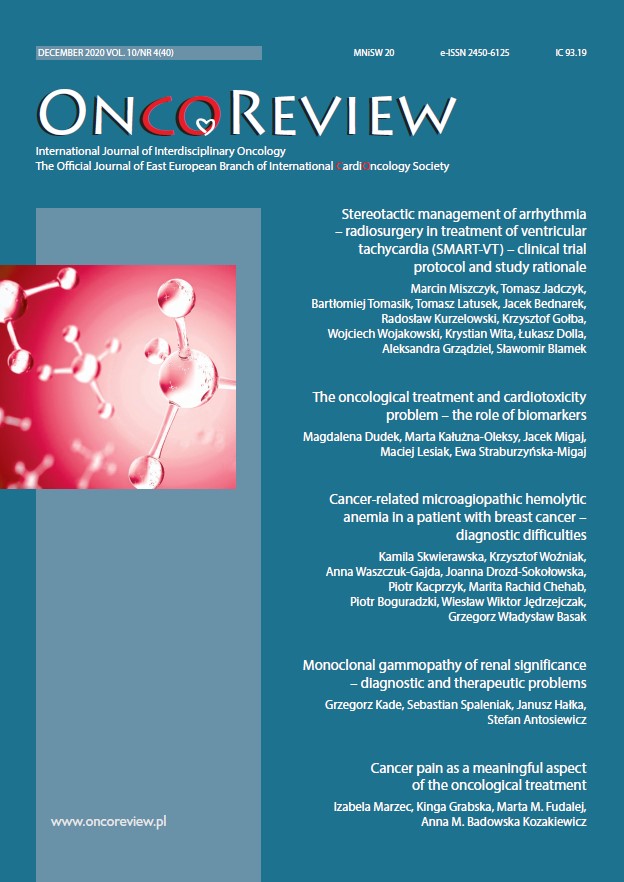The oncological treatment and cardiotoxicity problem – the role of biomarkers Review article
##plugins.themes.bootstrap3.article.main##
Abstrakt
Cancer and cardiovascular diseases are a leading causes of morbidity and mortality in developed countries. Cardiological complications of oncological treatment are a significant problem that can be manifested in both permanent and transient cardiac dysfunction including myocardial damage, left ventricular dysfunction, and heart failure, hypertension, ischemia, as well as arrhythmias or QT prolongation, which can be life-threatening. Early detection of cardiotoxicity due to cancer treatment is crucial in the prevention of adverse cardiovascular outcomes in this group of patients. In this review we try to summarize the role of biomarkers in the detection of cardiotoxicity due to cancer treatment.
Pobrania
##plugins.generic.paperbuzz.metrics##
##plugins.themes.bootstrap3.article.details##

Utwór dostępny jest na licencji Creative Commons Uznanie autorstwa – Użycie niekomercyjne – Bez utworów zależnych 4.0 Międzynarodowe.
Copyright: © Medical Education sp. z o.o. This is an Open Access article distributed under the terms of the Attribution-NonCommercial 4.0 International (CC BY-NC 4.0). License (https://creativecommons.org/licenses/by-nc/4.0/), allowing third parties to copy and redistribute the material in any medium or format and to remix, transform, and build upon the material, provided the original work is properly cited and states its license.
Address reprint requests to: Medical Education, Marcin Kuźma (marcin.kuzma@mededu.pl)
Bibliografia
2. Jemal A, Ward E, Thun M. Declining Death Rates Reflect Progress against Cancer. PLoS One. 2010; 5(3): e9584. https://doi.org/10.1371/journal.pone.0009584.
3. Cautela J, Lalevee N, Ammar C et al. Management and research in cancer treatment-related cardiovascular toxicity: Challenges and perspectives. Int J Cardiol. 2016; 224: 366-75. https://doi.org/10.1016/j.ijcard.2016.09.046.
4. Rugbjerg K, Mellemkjaer L, Boice JD et al. Cardiovascular disease in survivors of adolescent and young adult cancer: a Danish cohort study, 1943-2009. J Nat Cancer Inst. 2014; 106(6): dju110. https://doi.org/10.1093/jnci/dju110.
5. Suter TM, Ewer MS. Cancer drugs and the heart: importance and management. Eur Heart J. 2013; 34(15): 1102-11. https://doi.org/10.1093/eurheartj/ehs181.
6. Dudek M, Lesiak M, Straburzyńska-Migaj E et al. Powikłania sercowo-naczyniowe u pacjentów z chorobą nowotworową otrzymujących chemioterapię lub radioterapię. WDR. 2019; 50(1): 8-13. https://doi.org/10.5604/01.3001.0013.1683.
7. Zamorano JL, Lancellotti P, Rodriguez Muñoz D et al. 2016 ESC Position Paper on cancer treatments and cardiovascular toxicity developed under the auspices of the ESC Committee for Practice Guidelines. Eur J Heart Fail. 2017; 19(1): 9-42. https://doi.org/10.1002/ejhf.654.
8. Aleman BMP, Moser EC, Nuver J et al. Cardiovascular disease after cancer therapy. EJC Suppl. 2014; 12(1): 18-28. https://doi.org/10.1016/j.ejcsup.2014.03.002.
9. Chen MH, Colan SD, Diller L et al. Cardiovascular disease: cause of morbidity and mortality in adult survivors of childhood cancers. Circ Res. 2011; 108(5): 619-28. https://doi.org/10.1161/CIRCRESAHA.110.224519.
10. Plana JC, Galderisi M, Barac A et al. Expert consensus for multimodality imaging evaluation of adult patients during and after cancer therapy: a report from the American Society of Echocardiography and the European Association of Cardiovascular Imaging. J Am Soc Echocardiogr. 2014; 27(9): 911-39. https://doi.org/10.1016/j.echo.2014.07.012.
11. Ewer MS, Suter TM, Lenihan DL et al. Cardiovascular events among 1090 cancer patients treated with sunitinib, interferon, or placebo: a comprehensive adjudicated database analysis demonstrating clinically meaningful reversibility of cardiac events. Eur J Cancer. 2014; 50(12): 2162-70. https://doi.org/10.1016/j.ejca.2014.05.013.
12. Armenian SH, Lacchetti C, Barac A et al. Prevention and Monitoring of Cardiac Dysfunction in Survivors of Adult Cancers: American Society of Clinical Oncology Clinical Practice Guideline. J Clin Oncol. 2017; 35(8): 893-911. https://doi.org/10.1200/JCO.2016.70.5400.
13. Roffi M, Patrono C, Collet JP et al. 2015 ESC Guidelines for the management of acute coronary syndromes in patients presenting without persistent ST-segment elevation: Task Force for the Management of Acute Coronary Syndromes in Patients Presenting without Persistent ST-Segment Elevation of the European Society of Cardiology (ESC). Eur Heart J. 2016; 37(3): 267-315. https://doi.org/10.1093/eurheartj/ehv320.
14. Cardinale D, Sandri MT, Martinoni A et al. Left ventricular dysfunction predicted by early troponin I release after high-dose chemotherapy. J Am Coll Cardiol. 2000; 36(2): 517-22. https://doi.org/10.1016/s0735-1097(00)00748-8.
15. Ky B, Putt M, Sawaya H et al. Early Increases in Multiple Biomarkers Predict Subsequent Cardiotoxicity in Patients With Breast Cancer Treated With Doxorubicin, Taxanes, and Trastuzumab. J Am Coll Cardiol. 2014; 63(8): 809-16. https://doi.org/10.1016/j.jacc.2013.10.061.
16. Kitayama H, Kondo T, Sugiyama J et al. High-sensitive troponin T assay can predict anthracycline- and trastuzumab-induced cardiotoxicity in breast cancer patients. Breast Cancer. 2017; 24(6): 774-82. https://doi.org/10.1007/s12282-017-0778-8.
17. McCullough PA. B-type natriuretic peptides. A diagnostic breakthrough in heart failure. Minerva Cardioangiol. 2003; 51(2): 121-9.
18. Bouwer NI, Liesting C, Kofflardet MJM et al. NT-proBNP correlates with LVEF decline in HER2-positive breast cancer patients treated with trastuzumab. Cardiooncology. 2019; 5(1). https://doi.org/10.1186/s40959-019-0039-4.
19. Romano S, Fratini S, Ricevuto E et al. Serial measurements of NT-proBNP are predictive of not-high-dose anthracycline cardiotoxicity in breast cancer patients. Br J Cancer. 2011; 105(11): 1663-8. https://doi.org/10.1038/bjc.2011.439.
20. Lenihan DJ, Stevens PL, Massey M et al. The Utility of Point-of-Care Biomarkers to Detect Cardiotoxicity During Anthracycline Chemotherapy: A Feasibility Study. J Card Fail. 2016; 22(6): 433-8. https://doi.org/10.1016/j.cardfail.2016.04.003.
21. Canada JM, Thomas GK, Trankle CR et al. Increased C-reactive protein is associated with the severity of thoracic radiotherapy-induced cardiomyopathy. Cardiooncology. 2020; 6: 2. https://doi.org/10.1186/s40959-020-0058-1.
22. Putt M, Hahn VS, Januzzi JL et al. Longitudinal Changes in Multiple Biomarkers Are Associated with Cardiotoxicity in Breast Cancer Patients Treated with Doxorubicin, Taxanes, and Trastuzumab. Clin Chem. 2015; 61(9): 1164-72. https://doi.org/10.1373/clinchem.2015.241232.
23. Dudek M, Kałużna-Oleksy M, Migaj J et al. Clinical value of soluble ST2 in cardiology. Adv Clin Exp Med. 2020; 29(10): 1205-10. https://doi.org/10.17219/acem/126049.
24. Aimo A, Vergaro G, Passino C et al. Prognostic Value of Soluble Suppression of Tumorigenicity-2 in Chronic Heart Failure: A Meta-Analysis. JACC Heart Fail. 2017; 5(4): 280-6. https://doi.org/10.1016/j.jchf.2016.09.010.
25. Emdin M, Aimo A, Vergaro G et al. sST2 Predicts Outcome in Chronic Heart Failure Beyond NT-proBNP and High-Sensitivity Troponin T. J Am Coll Cardiol. 2018; 72(19): 2309-20. https://doi.org 10.1016/j.jacc.2018.08.2165.
26. Kalam K, Marwick TH. Role of cardioprotective therapy for prevention of cardiotoxicity with chemotherapy: a systematic review and meta-analysis. Eur J Cancer. 2013; 49(13): 2900-9. https://doi.org/10.1016/j.ejca.2013.04.030.
27. Słowik A, Jagielski P, Potocki P et al. Anthracycline-induced cardiotoxicity prevention with angiotensin-converting enzyme inhibitor ramipril in women with low-risk breast cancer: results of a prospective randomized study. Kardiol Pol. 2020; 78(2): 131-7. https://doi.org/10.33963/KP.15163.

